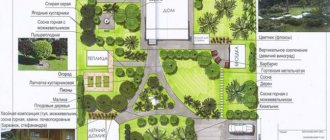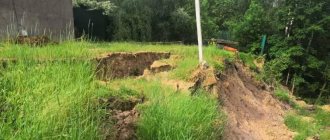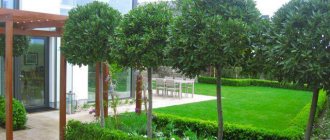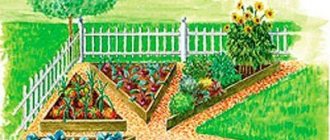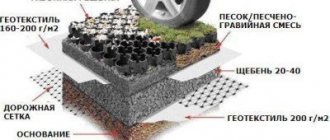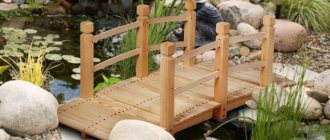You can make a suburban area beautiful by taking into account the practical use of the land. The planning of the vegetable garden and garden is carried out taking into account the characteristics of the soil and the location of the cardinal directions. On the territory free from beds and fruit trees, places for recreation are arranged and outbuildings are placed.
When starting to plan a vegetable garden or garden, it is important to understand what exactly you want to see on your site
Planning rules or how to plan a vegetable garden
Before drawing up a detailed plan, it is advisable to decide on the type of layout. Adherents of strict lines and forms prefer regular planning. Trees and shrubs are planted in even rows, beds and flower beds are made in the form of geometric shapes. The paths are also laid. The voids are filled with lawn.
It is necessary to start planning with a site diagram, on which the location of buildings, paths and areas allocated for the garden and vegetable garden should be noted
First of all, you need to decide on the place for the garden and the size of the allocated area.
There is a landscape layout, close to the natural style, of a garden plot and vegetable garden; how to draw up a garden plan is decided based on the features of the relief. Garden and garden crops are combined with ornamental plants and herbs. The planting plan for the summer cottage includes vegetable crops, fruit and stone fruit trees, and berry bushes. Many of them can be used as decorative elements.
The sunniest place is allocated for the beds, without shading on the south side
The length of the beds can be arbitrary, but the width is such that you can reach the middle of the bed with your hand
There are no standards for the ratio of the area of the garden and vegetable garden to the area of the plot; it all depends on the needs of the owners of the plot.
When arranging a vegetable garden, you should not mindlessly copy other people’s experience, but you should know some general principles
It is important to follow the basic rules:
- The vegetable garden is placed on a flat, warm place away from trees and tall buildings.
- Trees are planted on the north side so as not to cast a shadow on vegetable plantings.
- Berry bushes are used for zoning areas and hedges.
- Between the beds it is allowed to lay out flower beds and flower beds.
With the correct arrangement of beds and fruit trees, it will be possible to obtain a harvest and create a harmonious landscape design.
For cold climates, a greenhouse is not a luxury, but a necessity
Nowadays, it has become fashionable to arrange a decorative vegetable garden, in which vegetable crops also perform decorative functions.
Beetroot and carrots can be added to the flower garden. Decorative greenery will highlight the beauty of nasturtiums; calendula and marigolds will protect vegetable crops from insect pests.
When choosing plants for planting together, it is necessary to take into account their likes and dislikes.
Dividing the territory into zones
A rectangle for a garden and vegetable garden, of course, is easier to plan than a triangular or trapezoidal plot, a rhombus, or a plot on a slope. But even the most problematic area can be turned into a cozy landscape composition if you approach the design creatively.
Dividing the site into zones will help to correctly distribute the territory
Knowing the canons of zoning, you can independently plan a garden of 4 acres, 6, 8 or 12 for planting; the scheme provides for several main zones.
When zoning a territory, it is important to take into account the cardinal directions, prevailing winds and features of neighboring areas
The front door occupies 6–8%, it is immediately visible; the main decorative load falls on this territory. It is recommended to make a rock garden or rock garden with a minimum of green spaces, use vertical gardening, and border plantings along footpaths.
The front area is the face of the site, on which the first impression of the owners of the house depends
Fruit trees, berry gardens, and shrubs must not be placed near driveways or parking lots. Only decorative, unpretentious perennials are planted and lawns are made.
The gardening area is a place for planting useful crops, placing greenhouses, greenhouses. Usually occupies up to 75% of the site area; the sunniest areas are chosen. Fruit trees can be placed closer to the seating area to create pleasant shade. Berry trees are planted on borders to improve the landscape. It is better to provide tiered plantings - in the background - tall trees, then shrubs. In the foreground, when planning the beds, they are combined with flower beds and lawns.
Varieties of fruit trees and shrubs must be selected taking into account local climatic conditions
To successfully grow garden crops, you need fertile soil. If the soil on the site is poor, you will have to import black soil, plant green manure and apply mineral fertilizers
It is better to place household buildings in low-lying areas, hide them in the shade of trees, behind border plantings, and green hedges. A recreation area and playground occupy 10 to 15% of the site. Even in a small area you can plan a functional, cozy place with a barbecue, garden furniture, a gazebo, and a swing. Having decided on the proportions, we move on to the details. How to correctly place fruit trees and shrubs in the garden on the diagram can be seen in the selection of photos.
Outbuildings are usually located in the most inconvenient places for gardening crops
A recreation area with a gazebo or pergola is placed in the depths of the site away from the roadway
The playground should be clearly visible from anywhere on the site
Recommendations for arranging a site of non-standard shape
The layout of a plot of 12 acres, located on a slope, requires the construction of a house in the upper part. This will protect the structure from the effects of landslides and heavy rains. If the slope is steep, it should be divided into terraces. An alpine slide on a small flat area will look impressive.
A narrow plot requires the house to be placed near the short side. At the same time, the land will be used more rationally. If the garden area has the shape of a triangle, it is recommended to build the house closer to the red line of the street, on the side opposite the sharp peak.
Using the above recommendations, you can independently perform zoning of your estate without turning to specialists for help.
Mixed style of territory design
Free planning of a vegetable garden is a budget option for landscape design without strict zoning. Ideal for an area with uneven terrain, a variety of outbuildings in different places.
Mixed design style suits both small and large areas equally well
First, buildings are marked on the plan and shady areas are shaded. Sunny areas of the territory are used for cultural plantings, paths are laid in the rest, flower and stone compositions and lawns are made. They achieve rational use of all corners of the site, combining garden plantings with decorative ones. Useful crops are harmoniously woven into the design of the site and produce a good harvest.
With a mixed layout, plants are planted according to a pre-thought-out scheme, but not in a strict order, but in groups, combining fruit trees and shrubs with ornamental vegetation
When allocating a plot of land for fruit and stone fruit crops, the growth of the crown should be taken into account. You can use fruiting crops for background vegetation.
Layout of a plot of 6 acres: requirements of regulatory documents
This is precisely the area most often found in summer cottages, the configuration of which can be different. In our case, we will consider the most common option - the layout of a rectangular plot of 6 acres. Regardless of the wishes of the owners, the rules of SNiP 2.07.01-89 , which regulate the basics of planning and development, and SNiP 2.01.02-85 on fire safety standards, must be observed. According to these standards:
- a country house (or cottage) can be built in relation to the red line of the street no closer than 5 m;
- there must be a distance of at least 3 m between the house and the neighboring territory;
- there must be at least a meter between outbuildings and neighbors’ property;
- there must be a minimum of 6 m between the windows of the country house and the outbuildings of neighbors;
- poultry houses and outbuildings with domestic animals can be built at a distance of at least 15 m.
What are the best trees to plant?
Trees create a special atmosphere of comfort and color. The location of fruit and stone fruit trees depends on the level of groundwater. Crops need good drainage, room for roots to grow, and enough light. They will not grow in low-lying and flooded areas.
Fruit crops are selected taking into account their further growth and pollination needs
When planting low-growing berry bushes, their need for sunlight is taken into account.
There is a standard set of fruit-bearing zoned crops; apple trees, pears, plums, and cherries (grow throughout Russia) are selected from this list. In the middle zone, apricots bear fruit, mulberries grow, and sea buckthorn grows in the Urals and Siberia. Coniferous trees and shrubs always look advantageous.
Selection of ornamental plants
Berry bushes are chosen from the point of view of productivity and decorativeness. Gooseberries and currants are suitable for border and zone planting, hawthorn, red bird cherry, and chokeberry are suitable for hedges. Barberry and honeysuckle tolerate pruning well. Raspberries and blackberries are placed along the fence, along the boundaries of the site or in rows near outbuildings. Dogwood, shadberry, viburnum, and red-leaved apple trees are planted as ornamental plants.
For a small area, it is better to select unpretentious plants that can perform a dual role. For example, barberry - on the one hand, it is a beautiful ornamental plant, and on the other hand, it is a joy for cooks and connoisseurs of traditional medicine.
Dwarf apple and pear trees are another practical solution for a small area
When planning a vegetable garden, beds, plantings, the design takes into account the compatibility of plants, the biological characteristics of crops, and the requirements of agricultural technology: frequency of watering, requirements for lighting.
Planting a variety of plants on the site will allow you to enjoy an attractive view throughout the year.
You need to plan your landscaping for the entire season. Perennial flowers are added as annuals, taking into account the flowering period, so that there will be flowers in different parts of the area all season. Shrubs that change leaf color in the fall are placed in the front area. Unpretentious crops are placed in hard-to-reach places, while those requiring care are placed in a free access zone. Crops are combined compositionally, coniferous crops with deciduous ones.
To decorate rockeries, you can use herbs and different types of lettuce. Flowers are planted in vegetable beds to repel pests.
Don’t forget about ornamental plants, which play an important role in the overall atmosphere of the garden plot.
Options for planning a garden and vegetable garden on a site with diagrams, photos of the best design solutions are presented in the selection. Other people's works inspire you to realize your own ideas.
Hedge
This is an ideal option for drawing a border. The best plants that will cope with this role: viburnum leaf, white dogwood, privet, brilliant cotoneaster, hydrangea. A hedge will provide a clear separation of the vegetable garden. Will make the recreation area a more closed and secluded space. Let the plantings be located on the sunny side of the bushes.

